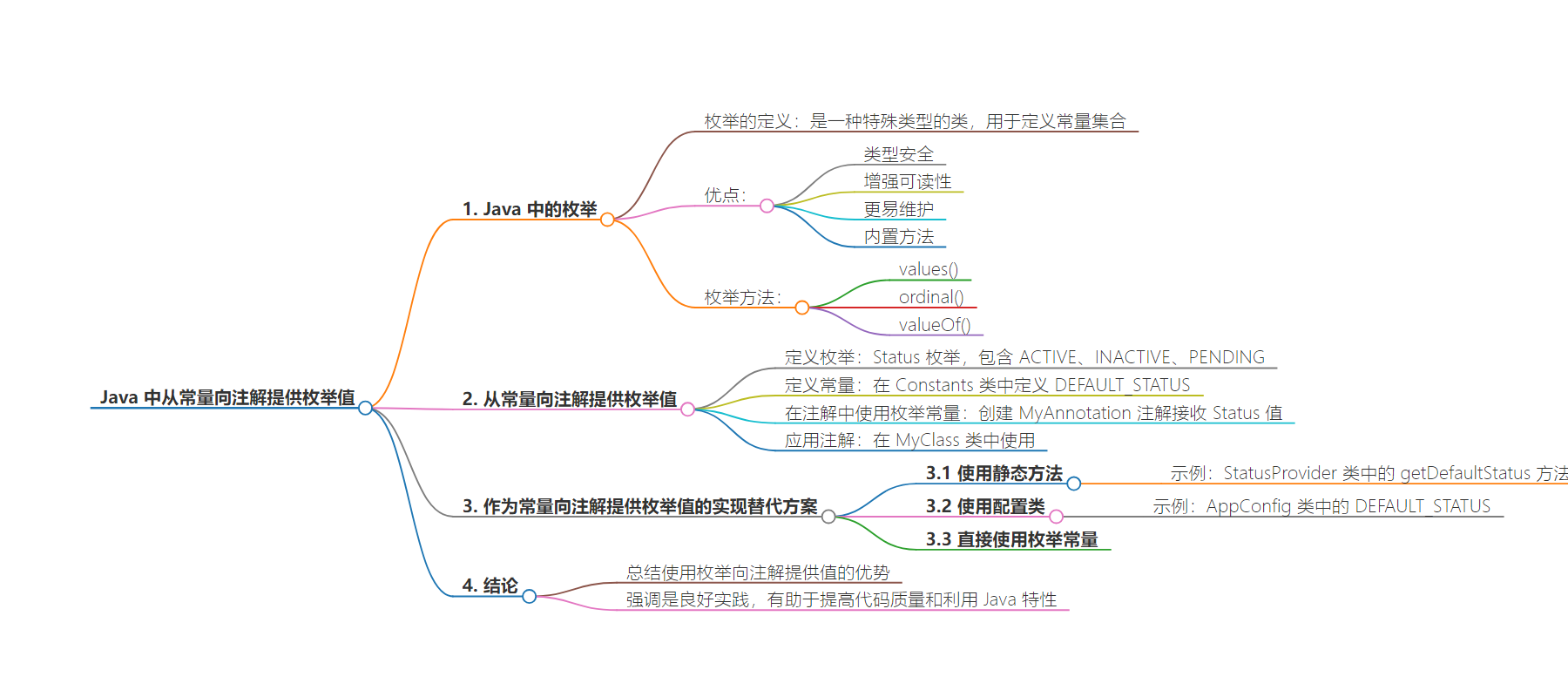包阅导读总结
1. 关键词:Java、Enum、Annotation、Constant、Best Practices
2. 总结:
本教程深入探讨了在 Java 中如何使用常量为注解提供枚举值,介绍了枚举的概念、优点及方法,阐述了多种实现方式,并强调了其对代码可读性、可维护性和类型安全性的提升,是一种良好的编程实践。
3. 主要内容:
– Java 中的枚举(Enum)
– 定义及简单示例
– 优点:类型安全、可读性、可维护性、内置方法
– 内置方法:values()、ordinal()、valueOf()
– 为注解从常量提供枚举值
– 定义枚举和常量
– 在注解中使用枚举常量
– 实现方式
– 使用静态方法
– 使用配置类
– 直接使用枚举常量
– 结论
– 总结通过枚举和常量提升代码质量
– 强调是良好的编程实践
思维导图:
文章地址:https://www.javacodegeeks.com/supply-enum-value-to-an-annotation-from-a-constant-in-java.html
文章来源:javacodegeeks.com
作者:Yatin Batra
发布时间:2024/7/10 10:13
语言:英文
总字数:825字
预计阅读时间:4分钟
评分:85分
标签:枚举,Java 注释,Java 基础,常量,类型安全
以下为原文内容
本内容来源于用户推荐转载,旨在分享知识与观点,如有侵权请联系删除 联系邮箱 media@ilingban.com
In this tutorial, we will delve into how Java allows us to use a constant to supply an enum value to an annotation, exploring various techniques and best practices.
1. What is Enum in Java?
Enums, short for enumerations, are a special type of class in Java used to define collections of constants. Enums are a powerful feature that allows developers to create variables that can only take one out of a small set of possible values. They enhance type safety and make the code more readable and maintainable. Here’s a simple example of an enum declaration:
public enum Day { SUNDAY, MONDAY, TUESDAY, WEDNESDAY, THURSDAY, FRIDAY, SATURDAY}
1.1 Benefits of Using Enums
Enums offer several benefits, including:
- Type Safety: Enums provide compile-time checking to ensure that only valid values are assigned to variables of the enum type.
- Readability: Enums make the code more readable by giving meaningful names to sets of values.
- Maintainability: Enums centralize the definition of constants, making it easier to update and manage them.
- Built-in Methods: Enums come with several built-in methods, such as
values(),ordinal(), andvalueOf(), that make it easier to work with them.
1.2 Enum Methods
Enums have several useful methods:
values()– Returns an array containing all of the values of the enum in the order they are declared.ordinal()– Returns the position of the enum constant in the enum declaration, where the initial constant is assigned an ordinal of zero.valueOf(String name)– Returns the enum constant with the specified name.
2. Supply Enum Value to an Annotation From a Constant
In Java, annotations can be used to provide metadata for classes, methods, and fields. Sometimes, we need to use an enum value as an argument to an annotation. To achieve this, we can define a constant that holds the enum value and supply it to the annotation. Here is how it can be done:
2.1 Define the Enum
public enum Status { ACTIVE, INACTIVE, PENDING}
2.2 Define the Constant
public class Constants { public static final Status DEFAULT_STATUS = Status.ACTIVE;}
2.3 Use the Enum Constant in an Annotation
import java.lang.annotation.Retention;import java.lang.annotation.RetentionPolicy;@Retention(RetentionPolicy.RUNTIME)public @interface MyAnnotation { Status status() default Status.ACTIVE;}@MyAnnotation(status = Constants.DEFAULT_STATUS)public class MyClass { // Class implementation}
In the example above:
- We define an enum called
Statuswith valuesACTIVE,INACTIVE, andPENDING. - We define a class
Constantsthat holds a constantDEFAULT_STATUSset toStatus.ACTIVE. - We create an annotation
MyAnnotationthat takes aStatusvalue as its argument. - We apply the annotation to a class
MyClass, using the constantConstants.DEFAULT_STATUSas the value for the annotation’sstatusattribute.
3. Implementation Alternatives to Supply Enum as Constants to an Annotation
3.1 Using a Static Method
One common method is to use a static method to return the desired enum value. This can be useful if the value needs to be computed or retrieved from some configuration.
public enum Status { ACTIVE, INACTIVE, PENDING}public class StatusProvider { public static Status getDefaultStatus() { // Logic to determine the default status return Status.ACTIVE; }}@Retention(RetentionPolicy.RUNTIME)public @interface MyAnnotation { Status status() default Status.ACTIVE;}@MyAnnotation(status = StatusProvider.getDefaultStatus())public class MyClass { // Class implementation}
This method provides more flexibility as it allows dynamic determination of the enum value.
3.2 Using a Configuration Class
In complex applications, you might use a configuration class to manage default values. This can be especially useful when dealing with multiple enums and configurations.
public enum Status { ACTIVE, INACTIVE, PENDING}public class AppConfig { public static final Status DEFAULT_STATUS = Status.ACTIVE;}@Retention(RetentionPolicy.RUNTIME)public @interface MyAnnotation { Status status() default Status.ACTIVE;}@MyAnnotation(status = AppConfig.DEFAULT_STATUS)public class MyClass { // Class implementation}
This approach helps organize configuration settings in a single place, promoting better management and readability.
3.3 Using Enum Constants Directly
For simple use cases, you might directly use the enum constants in annotations without defining separate constants or methods. While this approach is straightforward, it may not be as maintainable for larger projects.
public enum Status { ACTIVE, INACTIVE, PENDING}@Retention(RetentionPolicy.RUNTIME)public @interface MyAnnotation { Status status() default Status.ACTIVE;}@MyAnnotation(status = Status.ACTIVE)public class MyClass { // Class implementation}
This method is direct and easy to implement but lacks the centralization and flexibility of the other methods.
4. Conclusion
In this tutorial, we’ve thoroughly examined how to supply an enum value from a constant to an annotation in Java. By leveraging enums, we can enhance the readability, maintainability, and type safety of our code. The ability to use constants to assign enum values to annotations provides a flexible and centralized approach to managing these values, reducing the risk of errors and making updates more straightforward.
Overall, the strategic use of enums and constants in annotations is a best practice that contributes to cleaner, more maintainable codebases. Embracing these patterns will improve your code’s quality and help you harness the full power of Java’s type system and annotation capabilities.
